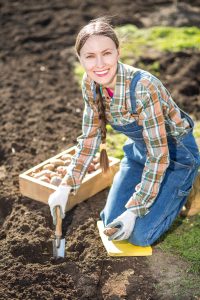8 Tips To Prevent Gardening Back Pain
 Spring has finally arrived here in St Louis. Many people are eagerly planning and preparing to get their gardens in, anticipating the fresh and healthy vegetables.
Spring has finally arrived here in St Louis. Many people are eagerly planning and preparing to get their gardens in, anticipating the fresh and healthy vegetables.
Unfortunately, while many plan their gardens, many fail to plan or prepare for the actual work required to prepare and plant the garden. It is not uncommon for those who have been sedentary through the winter months to just jump in and go to work on the garden. Unfortunately, it is also not uncommon for some to suffer injuries or low back pain from their efforts.
To help prevent gardening low back pain, we offer the following 8 tips.
1. Warm Up
The first way to prevent gardening back pain is to warm up! While you may not necessarily associate gardening with exercise, it truly can be a real workout. Just like exercise, warming up your muscles first is a great idea to help prevent pulling a muscle. A great way to warm up is to take a 5-10 minute brisk walk. After walking try some gentle stretching of your low back. CLICK HERE for basic low back stretches.
2. Proper Lifting
Preparing a garden may require lifting heavy bags of mulch, soil or fertilizer. One of the most common ways to injure the low back during gardening is improper lifting. You should always remember to use proper body mechanics.
Most importantly, lift with your legs. Squat down close to the object you want to lift and grab with both of your hands. Keeping the back straight, stand up using your legs and not pulling with your low back.
Avoid lifting from a bent over position and then twisting. This puts a twisting force on the disc of the low back as well as the smaller joints between the vertebra. This type of force can result in damage to the disc or joints, causing gardening back pain.
3. Don’t Lean Over
Leaning over places a lot of pressure on the disc of the low back as well as strain on the muscles alongside the low back – increasing the chance of injury. Instead of leaning over, use a pad to kneel on, a small stool to sit on or even a 5 gallon bucket.
4. Know How To Dig
Minimize the risk of back injury or muscle strain by using good body mechanics when digging with a shovel. Using our weight as leverage is the key.
Good body alignment is where to begin. First, face the direction you want to place the dirt. Then use your weight to lean into the shovel, rather than attempting to muscle through with our upper body.
When you are ready to dump the dirt, toss it straight ahead of you. Resist the urge to twist your body while dumping the dirt. Repetitive twisting with a load at the end of the shovel puts stress on the disc of the low back and can result in injury.
5. Plant a Raised Garden
Instead of planting a garden in the ground, find ways to raise it up so you do not have to bend over. You can use large planters or create wall type gardens. You do not have to raise them a lot: a foot or two off the ground will make it much easier when combined with a small stool to sit on.
6. Switch Hands When Using Tools
When using things like a shovel, rake or hoe, don’t constantly use your dominant side. If you do, you are using you muscles in an uneven fashion, which can cause an overuse injury to one side.
7. Switch Activities Throughout The Day
If you are going to spend over a couple of hours gardening, switch activities regularly. Not mixing things up can result in a repetitive overuse injury to the muscles or joints.
8. Use Back Friendly Tools
Using the right tools can not only make gardening easier, it can help prevent injury and gardening back pain. Do an internet search for “ergonomic gardening tools” and you should find numerous website with a large selection to choose from.
Consistently being mindful of these 8 tips should go a long way to prevent gardening back pain and help you enjoy the “fruits” of your gardening!
Disclaimer: This information is not to be substituted for professional advice. If you suffer from chronic pain, especially in the low back: DO NOT attempt these suggestions. Seek professional advice. Chronic low back pain can be an indication of an underlying structural problem that could result in a more serious injury if you attempt these actions. If you have any questions call our office at (314) 731-4383 or CLICK TO CALL NOW
